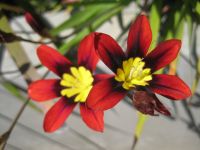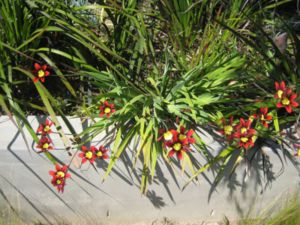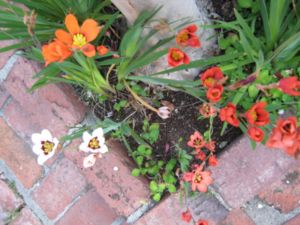Sparaxis tricolor: Difference between revisions
No edit summary |
No edit summary |
||
| Line 1: | Line 1: | ||
{{Inc| | |||
Sparaxis tricolor, Ker. Fig. 3654. Differs from S. grandiflora only in the color of the fls., which are very variable but always have a bright yellow throat and often a dark blotch at the base of each segm. B.M. 381 (as Ixia tricolor); 1482. F.S. 2:124. F. 1843:213 (as S. picta, S. purpurea, S. pulchella).—According to Baker, this is the favorite species among cultivators. It certainly has the greatest variety of colors and markings. In the works cited the floral segms. range from nearly white through rose, brick-red, carmine, crimson, and light purple to dark purple, excluding blue and yellow, which latter color usually appears in the throat. | |||
}} | |||
{{Taxobox | {{Taxobox | ||
| name = Wandflower | | name = Wandflower | ||
Revision as of 18:06, 15 July 2009
| Standard Cyclopedia of Horticulture |
|---|
|
Sparaxis tricolor, Ker. Fig. 3654. Differs from S. grandiflora only in the color of the fls., which are very variable but always have a bright yellow throat and often a dark blotch at the base of each segm. B.M. 381 (as Ixia tricolor); 1482. F.S. 2:124. F. 1843:213 (as S. picta, S. purpurea, S. pulchella).—According to Baker, this is the favorite species among cultivators. It certainly has the greatest variety of colors and markings. In the works cited the floral segms. range from nearly white through rose, brick-red, carmine, crimson, and light purple to dark purple, excluding blue and yellow, which latter color usually appears in the throat.
|
| Wandflower {{{status}}} Fossil range: {{{fossil_range}}}
| ||||||||||||||||||||||||||||||||||||||||||||||||||||||||||||||||||
|---|---|---|---|---|---|---|---|---|---|---|---|---|---|---|---|---|---|---|---|---|---|---|---|---|---|---|---|---|---|---|---|---|---|---|---|---|---|---|---|---|---|---|---|---|---|---|---|---|---|---|---|---|---|---|---|---|---|---|---|---|---|---|---|---|---|---|
 | ||||||||||||||||||||||||||||||||||||||||||||||||||||||||||||||||||
| Plant Info | ||||||||||||||||||||||||||||||||||||||||||||||||||||||||||||||||||
| ||||||||||||||||||||||||||||||||||||||||||||||||||||||||||||||||||
| Scientific classification | ||||||||||||||||||||||||||||||||||||||||||||||||||||||||||||||||||
| ||||||||||||||||||||||||||||||||||||||||||||||||||||||||||||||||||
| [[{{{diversity_link}}}|Diversity]] | ||||||||||||||||||||||||||||||||||||||||||||||||||||||||||||||||||
| {{{diversity}}} | ||||||||||||||||||||||||||||||||||||||||||||||||||||||||||||||||||
| Binomial name | ||||||||||||||||||||||||||||||||||||||||||||||||||||||||||||||||||
| Sparaxis tricolor | ||||||||||||||||||||||||||||||||||||||||||||||||||||||||||||||||||
| Trinomial name | ||||||||||||||||||||||||||||||||||||||||||||||||||||||||||||||||||
| {{{trinomial}}} | ||||||||||||||||||||||||||||||||||||||||||||||||||||||||||||||||||
| Type Species | ||||||||||||||||||||||||||||||||||||||||||||||||||||||||||||||||||
| {{{type_species}}} | ||||||||||||||||||||||||||||||||||||||||||||||||||||||||||||||||||
| {{{subdivision_ranks}}} | ||||||||||||||||||||||||||||||||||||||||||||||||||||||||||||||||||
| [[Image:{{{range_map}}}|{{{range_map_width}}}|]] | ||||||||||||||||||||||||||||||||||||||||||||||||||||||||||||||||||
| Synonyms | ||||||||||||||||||||||||||||||||||||||||||||||||||||||||||||||||||
| {{{synonyms}}} |


Sparaxis tricolor, also known as the Wandflower, Harlequin flower or Sparaxis, is a bulb-forming perennial plant that grows in well-drained sunny soil. It gained its name from its extremely colorful flowers which are bi or tri-coloured with a golden centre and a small ring of brown surrounded by another colour.